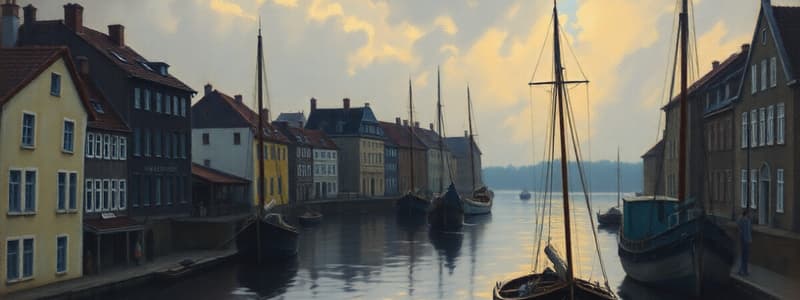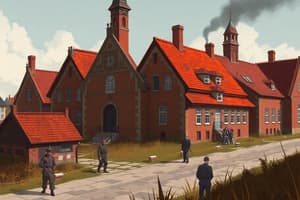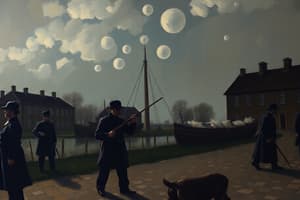Podcast
Questions and Answers
Given the socio-political climate and the characters' expressed sentiments, extrapolate the underlying philosophical argument implicitly posited by Papa's decision not to engage in armed resistance against the Nazi occupation. Which tenet most accurately reflects the ethical dilemma in such circumstances?
Given the socio-political climate and the characters' expressed sentiments, extrapolate the underlying philosophical argument implicitly posited by Papa's decision not to engage in armed resistance against the Nazi occupation. Which tenet most accurately reflects the ethical dilemma in such circumstances?
- Deontological imperatives forbidding any form of collaboration with an immoral regime.
- Existentialist notions advocating for authentic action regardless of consequence.
- A Nietzschean perspective championing the will to power and self-preservation above all else.
- A utilitarian calculus prioritizing aggregate survival over individual heroic acts. (correct)
Considering Annemarie's developmental stage as a seven-year-old, analyze the psychological implications of her inquiry regarding her mother’s willingness to die for the King. What primary cognitive process is she engaging in, and what underlying emotional needs might be driving this line of questioning?
Considering Annemarie's developmental stage as a seven-year-old, analyze the psychological implications of her inquiry regarding her mother’s willingness to die for the King. What primary cognitive process is she engaging in, and what underlying emotional needs might be driving this line of questioning?
- She is testing cause-and-effect relationships driven by a curiosity about historical events.
- She is exhibiting preoperational egocentrism driven by a need for personal recognition.
- She is demonstrating concrete operational thinking driven by a desire to understand the King's power.
- She is engaging in abstract hypothetical reasoning driven by a need for reassurance about familial safety and stability. (correct)
In the context of WWII-era occupied Europe, assess Mama's seemingly benign act of crocheting a piece of clothing for Lise's upcoming marriage. Beyond its surface appearance, what potential subversive functions could such seemingly innocuous domestic activities serve within an environment of surveillance and resistance?
In the context of WWII-era occupied Europe, assess Mama's seemingly benign act of crocheting a piece of clothing for Lise's upcoming marriage. Beyond its surface appearance, what potential subversive functions could such seemingly innocuous domestic activities serve within an environment of surveillance and resistance?
- It contributed to the black market economy, providing essential goods while subverting Nazi economic controls.
- It facilitated the creation of symbolic effigies designed to undermine the morale of the enemy soldiers.
- It provided a pretext for gatherings and discussions, offering safe haven from the occupying forces. (correct)
- It served as a covert means of transmitting coded messages to the resistance through the pattern of stitches.
Given the statement that 'every Danish citizen would die for King Christian to protect him', determine its historical accuracy, considering the reality of both Danish collaboration and resistance during the Nazi occupation. How does this statement function narratively, and what complexities does it obscure regarding the spectrum of Danish responses to the occupation?
Given the statement that 'every Danish citizen would die for King Christian to protect him', determine its historical accuracy, considering the reality of both Danish collaboration and resistance during the Nazi occupation. How does this statement function narratively, and what complexities does it obscure regarding the spectrum of Danish responses to the occupation?
Considering the geopolitical realities of Scandinavia during World War II, what critical strategic advantage did Sweden possess that allowed it to remain neutral, unlike Denmark and Norway, and how did that neutrality impact its internal political dynamics and its relationship with neighboring occupied nations?
Considering the geopolitical realities of Scandinavia during World War II, what critical strategic advantage did Sweden possess that allowed it to remain neutral, unlike Denmark and Norway, and how did that neutrality impact its internal political dynamics and its relationship with neighboring occupied nations?
Flashcards
Annemarie
Annemarie
A seven-year-old girl in Denmark concerned about her country's safety.
King Christian
King Christian
The king of Denmark whom citizens would die to protect.
Nazi Occupation
Nazi Occupation
The control of Germany over countries like Denmark, Norway, and others during WWII.
Danish Citizen Loyalty
Danish Citizen Loyalty
Signup and view all the flashcards
Geography of Occupation
Geography of Occupation
Signup and view all the flashcards
Study Notes
Annemarie's Questions About the War
-
Annemarie, age seven, questioned her father, Papa, about why the king couldn't protect Denmark from the Nazis.
-
Papa explained Denmark was a small country, and the Nazi forces were overwhelming, so the king chose not to fight.
-
Annemarie noted Norway fought fiercely, but the Nazis still conquered them due to their geographic features.
The Geography of War
-
Annemarie visualized Norway on a map as pink.
-
She contrasted this with a blue Sweden, indicating the absence of German soldiers in Sweden.
-
She recognized the importance of geography and its impact on the war, using a geographical understanding.
-
Annemarie was aware of the war in nearby areas like Holland, Belgium, and France.
Family and Wartime Life
-
Annemarie's family discussed the war situation in different European countries.
-
Mama, silently crocheting, observed and valued her children's interest in the world.
-
Annemarie's family's life was intertwined with the war, highlighting the impact on the lives of ordinary people.
-
Lise, a grown-up, was about to marry Peter Nielsen adding an element of personal events to an understanding of the war.
Studying That Suits You
Use AI to generate personalized quizzes and flashcards to suit your learning preferences.



